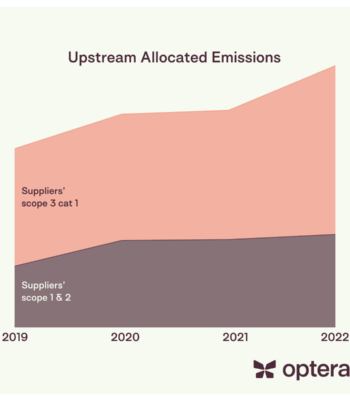Scope 3 emissions reporting has been called “the wild west,” and for good reason. With emissions that originate outside the business, it can feel impossible to get your hands on data at all, let alone data that’s specific, accurate, and actionable. However, scope 3 makes up an enormous percentage of most companies’ climate impact—across all sectors, an average of 75 percent of overall emissions—and it is therefore essential for companies to be proactive in managing it. That starts with reporting reliable data.
Last week, Optera CEO and co-founder Tim Weiss sat down with Lowe’s VP of Corporate Sustainability Chris Cassell at a SXSW conference session to zero in on downstream emissions, in particular scope 3, category 11, or emissions coming from the use of sold products. Optera is partnering with the Retail Industry Leaders Association (RILA), Lowe’s and other major retailers, plus NGOs and government agencies to make scope 3, category 11 emissions data available to all retailers. Why use of sold products specifically? For many retailers, this one category can account for the majority of their overall emissions.
Below is a recap of Tim and Chris’ SXSW conversation and a preview of how, in the near future, retailers will have a shared source for this data at their fingertips.
Update: The Direct-Use Product Emissions Database is now available! Click here to learn more and access the database.
Current state of corporate climate action
A vast majority of large retailers are, or soon will be, subject to regulations that require the disclosure of emissions data. These regulations have already been passed in the EU, California, and the US at large thanks to new climate disclosure rules from the SEC. In the EU specifically, retailers will also be subject to carbon border taxes on emissions-intensive imports.
And it’s not just regulators placing increased scrutiny on emissions—it’s coming from inside the house too. In boardrooms and C-suites across the globe, there is an unprecedented level of attention on the transition to a low-carbon economy. The focus on sustainability has spread outside of the ESG team to include finance teams, operations teams, marketing teams, and executives. Nearly 5,000 companies have set science-based targets for emissions reduction, and 3,000 have made net zero commitments.
However, despite the increased focus on sustainability, the world remains skeptical of corporate climate action. That skepticism is warranted, according to Tim. “We’re not seeing the results…companies are not hitting their goals, because they’re really hard to hit,” he explained. “The companies we work with are not satisfied with their progress, they want to do more. The challenge is unblocking that action and enabling it to happen.”
So what’s in their way? Fear of getting it wrong and overstating their impact is a major factor. “There’s this generalized trepidation across the corporate sector that it’s easier to do nothing because it’s lower risk for the company,” Tim said. The risk of being accused of greenwashing or being blacklisted by leading climate benchmarks is real. So are the gaps in solutions; while significant progress has been made, not all manufacturing can be done sustainably and at a reasonable cost—yet.
Another major hurdle facing companies today is a lack of data. When the bulk of a company’s emissions originate upstream or downstream, and the company doesn’t have access to the data associated with those emissions, they can’t prioritize action or demonstrate progress.
What does scope 3, category 11 emissions management look like on the individual retailer level?
Lowe’s has reported their scope 1 and 2 emissions for over a decade. Scope 3, however, presented a daunting challenge; scope 3 emissions accounted for over 99 percent of Lowe’s total emissions, and over 80 percent of scope 3 emissions came from category 11—use of sold products. That meant that the vast majority of Lowe’s emissions data was not being captured, because the emissions were happening within customer households.
The Lowe’s team set out to solve this challenge. While they had some data, most of the calculations required a set of assumptions—and the end calculation could vary wildly based on small tweaks to those assumptions. For example, does a typical household use their lawnmower 4 hours a month, or 8? Do they use their lawn mower for 5 years before replacing it, or do they hang onto it for a little longer? How much fuel does their lawn mower use per hour? Where those assumptions land has a massive impact on the eventual emissions estimate—and that’s just for one product type out of millions. On top of that, while Lowe’s was calculating scope 3 category 11 emissions with one set of assumptions, every other retailer was working from their own unique assumptions. Across the retail sector, data on use of sold product emissions was inconsistent.
In order for emissions reporting to be meaningful and to drive impactful reductions, everyone needs to be on the same page, industry-wide, and using the same data. The first step toward that goal was involving the EPA, who calculates the emissions of EnergyStar products annually. Thanks to a request from the Lowe’s team, the EPA EnergyStar database is now published online so all retailers—and the public—can work from the same data.
But that covers only EnergyStar products—about half of Lowe’s inventory. Chris and the team pictured a world where retailers worked together, from a set of shared assumptions, to calculate emissions consistently for all their products. That’s where RILA and Optera came in.
Filling the gaps in scope 3 category 11 data
Lowe’s was far from alone in facing down the challenge of calculating scope 3 category 11 emissions. In fact, so many of the world’s largest retailers were dealing with the same issue that RILA partnered with Optera and convened a committee of retailers, government agencies, and NGOs to solve it. The goal of the partnership is to develop one shared database and methodology for calculating use of sold products emissions.
The outcome is called the Direct Use Product Emissions Database (DPED). Combining data from suppliers and the EPA with specific product data, intensive research, and a collaborative design process, the database provides consistent, specific emissions data for 200 product categories and will soon be available to any retailer who wants access.
With access to the same data as their peers, retailers will be able to accurately report their scope 3 category 11 emissions and subsequently can focus on their most emissions-intense product categories for decarbonization efforts. Accurate and specific data also paves the way for transparency with regulators, customers, and investors, and eventually accurate product carbon footprints at the consumer level.
What is the potential impact of having accurate scope 3 category 11 emissions data?
The United States accounts for close to 13 percent of global emissions, and residential emissions make up 20 percent of total US emissions—nearly a billion metric tons CO2e. More efficient solutions exist for most of the highest-emitting appliances in a typical home; equipping consumers to choose those options starts with education.
Beyond providing product carbon footprints to consumers at the point of purchase, having access to reliable product use emissions data empowers retailers to work with their suppliers as well. When big retailers partner with each other and with their suppliers to make more efficient products, and consumers have the knowledge to choose those products, residential emissions, retailer emissions, and manufacturer emissions can start to meaningfully change in the right direction.
Scope 3 is no longer the wild west
With accurate, reliable, and consistent data available industry-wide, scope 3 can begin to shed its reputation as the wild west of emissions reporting. The DPED is one step of many toward meaningful climate action, and its impact will hopefully be felt beyond retail. Retailers work with manufacturers and suppliers, who work with other suppliers and other customers. When one company takes action, it influences others. “No one is in a silo,” Tim said. “This sort of direct retail engagement is setting the table to open up opportunity across many different sectors.”
Access the Direct-Use Product Emissions Database
The DPED is now available. To learn more and access the database, click here.


